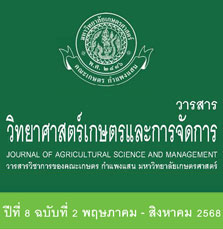ความหลากหลายทางพันธุกรรมของถั่วเขียวฉายรังสี ชั่วที่ 5
คำสำคัญ:
กลายพันธุ์, ความหลากหลายทางพันธุกรรม, เครื่องหมายเอสเอสอาร์บทคัดย่อ
การประเมินผลผลิตของถั่วเขียวฉายรังสีอิเล็กตรอนชั่วที่ 5 (M5) จากถั่วเขียวพันธุ์ตั้งต้น ได้แก่ พันธุ์ Chai Nat 84-1 และ Chai Nat 3 ศึกษาด้วยการวางแผนการทดลอง RCB 3 ซ้ำ พบว่ามีความแตกต่างกันอย่างมีนัยสำคัญทางสถิติ (p ≤ 0.5) ถั่วเขียวฉายรังสี M5 Chai Nat 84-1 มีผลผลิต (98.25-105.50 กิโลกรัมต่อไร่) สูงกว่าพันธุ์ตั้งต้น (84.90 กิโลกรัมต่อไร่) ถั่วเขียวฉายรังสี M5 Chai Nat 3 มีผลผลิต 70.65-127.00 กิโลกรัมต่อไร่ สูงกว่าพันธุ์ตั้งต้น (70.20 กิโลกรัมต่อไร่) ผลผลิตที่สูงขึ้นอาจเป็นผลจากอิทธิพลของสิ่งแวดล้อม และเพื่อศึกษาความหลากหลายทางพันธุกรรมของถั่วเขียวฉายรังสี M5 และพันธุ์ตั้งต้น ด้วยเครื่องหมายเอสเอสอาร์ 9 เครื่องหมาย พบว่าสามารถแยกถั่วเขียวฉายรังสี M5 ที่มีผลผลิตสูงออกจากพันธุ์ตั้งต้นได้ จึงยืนยันว่าเป็นสายพันธุ์กลายจริง และนำเข้าขั้นตอนการเปรียบเทียบผลผลิตเบื้องต้นต่อไป
เอกสารอ้างอิง
Arumingtyas, E.L. and A.N. Ahyar. 2022. Genetic diversity of chili pepper mutant (Capsicum frutescens L.) resulted from gamma-ray radiation. IOP Conference Series: Earth and Environmental Science 1097.012059. Doi: 10/1088/1755-1315/1097/1-012059.
Baojiang G., P. Qishen and A. Kolman. 1989. Cytogenetic effects of electron-beam radiation on dry seed storage. Heriditas 110: 113-115.
Houglund, E., E. Blomquist, J. Carlsson and B. Stenerlow. 2000. DNA damage induced by radiation of different linear energy transfer: initial fragmentation. International Journal of Radiation Biology 76: 539-547.
Huppertz, M., L. Manasa, D. Kachhap, A. Dalai, N. Yadav, M.A. Khan, P. Bauer and K.C.S. Panigrahi. 2013. Review: Exploring the potential of mung bean: sustainability and genomics in a changing world. 1-24. (Online): Available Source: http;//osf.io/mzrbh/download (September 1, 2023).
Jaccard, P. 1908. Nouvelles recherches surl la distribution florale. Bulletin de la Societe vaudoise des sciences naturelles 44: 223-270.
Khan, S. 1990. Studies on chemical mutagenesis in mungbean (Vigna radiata (L.) Wilczek). Ph.D. Thesis, Aligarh Muslim University.
Kitiya, A. 2019. ISSR and SSR markers linked to powdery mildew and cercospora leaf spot resistance in mungbean. Ph.D. Thesis, Suranaree University of Technology.
Kumer, V., H.K. Dikshit, N. Jain, J. Kumari, D. Singh, A. Singh, R. Tak and T.R. Sharma. 2012. Genetic diversity in mungbean [Vigna radiata (L.) Wilczek] and related Vigna spp. Detected by ISSR, URP and markers. Indian Journal of Genetics and Plant Breeding 72 (3): 318-324.
Mounika, Y. 2020. Effects of mutagens on various traits in mungbean (Vigna radiata L. Wilczek). International Journal of Current Microbiology and Applied Sciences 11: 394-402.
Oladosu, Y., M.Y. Rafii, N. Abdullah, G. Hussin, A. Ramli, H.A. Rahim, G. Miah and M. Usman. 2016. Principle and application of plant mutagenesis in crop improvement: a review. Biotechnology and Biotechnological Equipment 30 (1): 1-16. Doi:10.1080/13102818.2015.1087333.
Pavithra, B.S., L. Behera and K.C. Samal. 2021. Genetic diversity analysis and validation of microsatellite markers linked with tolerance to powdery mildew disease in mungbean [Vigna radiata (L.) Wilczek]. Legume Research 1-10. Doi: 10.18805/LR-4472.
Sangiri, C. A. Kaga, N. Tomooka, D. Vaughan and P. Srinives. 2007. Genetic diversity of the mungbean (Vigna radiata, Leguminosae) genepool on the basis of microsatellite analysis. Australian Journal of Botany 837-847.
Souframanien, J., K.S. Reddy, V.C. Petwal and J. Dwivedi. 2016. Comparative effectiveness and efficiency of electron beam and 60Co Ɣ- rays in induction of mutations in black gram [Vigna mungo (L.) Hepper]. Journal of Food Legumes 29 (1): 1-6.






